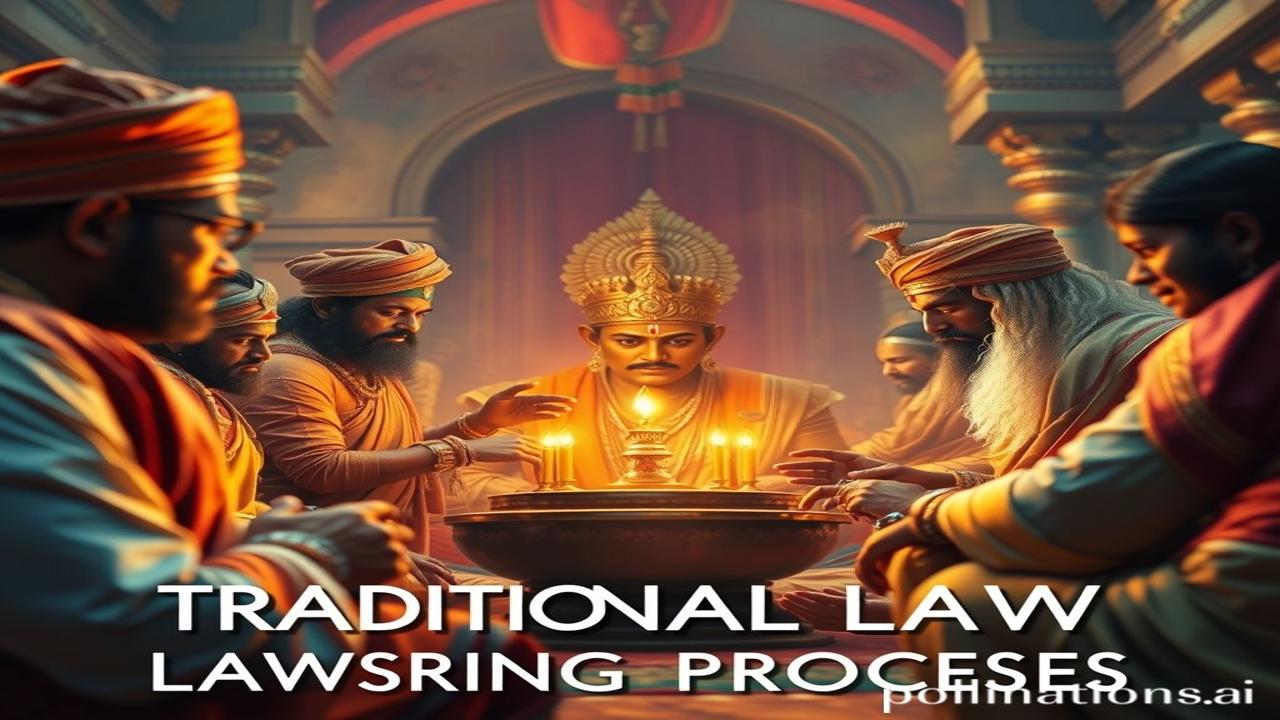Waqt Ki Dhool Mein Chhupi Vidhi: Unraveling India’s Ancient Law-Making
Kabhi socha hai, jo kanoon aaj hum follow karte hain, unki shuruaat kahaan se hui thi? Imagine walking down a dusty lane in ancient India, the air thick with the scent of incense and turmeric, the rhythmic chanting of Vedic hymns echoing in your ears. It’s here, amidst the bustling marketplaces and serene ashrams, that the seeds of our legal systems were sown. These weren’t laws etched in stone tablets and debated in parliaments like today. They were interwoven into the very fabric of life, passed down through generations, and shaped by a complex interplay of religion, customs, and the wisdom of elders.
The Genesis of Dharma: Tracing the Roots of Traditional Law-Making
Traditional law-making in India isn’t about a single event or date; it’s an evolving process spanning millennia. Think back to the Vedic period (1500-500 BCE), where the concept of Dharma reigned supreme. Dharma wasn’t just religion; it was a cosmic order, a code of conduct guiding individuals and society. The Vedas, especially the Smritis (like Manusmriti), became the primary sources of these laws. These weren’t dictates from a central authority, but rather interpretations of Dharma by learned Brahmins and wise men. Imagine the Guru-Shishya tradition, where knowledge was meticulously passed on, debated, and adapted to suit the changing times. This wasn’t a rigid legal system, but a fluid, evolving understanding of right and wrong. The Arthashastra by Kautilya, written around 3rd century BCE, added another layer, focusing on statecraft, economics, and pragmatic governance, further influencing the legal landscape.
From Sacred Texts to Local Customs: The Rise of Panchayats
But Dharma wasn’t confined to sacred texts. Life at the grassroots level was governed by local customs and traditions. The Panchayats – village councils – played a crucial role in resolving disputes and enforcing social norms. Imagine a bustling village square, the air filled with the voices of farmers, artisans, and elders, deliberating on a conflict over land or a breach of social conduct. The Sarpanch, usually a respected elder, would lead the discussion, drawing upon local customs and the wisdom of the community to arrive at a just decision. These decisions weren’t necessarily written down; they were held in the collective memory of the community, reinforced through social pressure and the fear of ostracization.
Ruling the Realm: Kings, Courts, and the Pursuit of Justice
Rulers, too, played a vital role. While Dharma provided the moral compass, kings were responsible for maintaining order and dispensing justice. They often relied on Dharmashastras (treatises on Dharma) and consulted with learned advisors. However, the system wasn’t always fair or equitable. Power dynamics, caste hierarchies, and personal biases often influenced judicial decisions. But even within these limitations, the pursuit of Nyaya (justice) remained a core principle. Imagine a royal court, filled with petitioners seeking redress, the air thick with anticipation, the king listening intently to both sides of the story before pronouncing his judgment.
Ma Rukmini Ka Nyaya: A Day in Ancient Ayodhya
Let’s peek into a day in ancient Ayodhya. Ma Rukmini, a potter’s wife, had her clay pots stolen from the marketplace. Heartbroken, she went to the village Panchayat. Picture her, draped in a simple cotton sari, her face etched with worry, as she pleaded her case before the Sarpanch. The Sarpanch, a wise old man named Dada Ramu, listened patiently, questioned witnesses, and examined the remaining shards of clay. After much deliberation, he ordered the thief to compensate Rukmini for her loss and publicly apologize for his transgression. Rukmini left the Panchayat, her heart filled with gratitude. She knew Dharma had prevailed.
Dharaohar: Echoes of Tradition in Modern India
Even today, the echoes of these traditional law-making processes resonate in India. While we now have a codified legal system based on the Constitution, the spirit of Panchayati Raj continues to thrive in rural areas. Local customs and traditions often influence judicial decisions, particularly in matters of family law and property disputes. The emphasis on mediation and reconciliation, a hallmark of traditional justice systems, is increasingly being adopted in modern courts. Dharma, though no longer the sole basis for law, still shapes our moral compass and informs our understanding of right and wrong. We see this influence in our emphasis on social justice, equality, and the pursuit of a harmonious society. Bharatiyata, that elusive feeling of Indianness, is deeply intertwined with these ancient principles of Dharma and Nyaya.
Myth-Buster: Manusmriti – The Good, The Bad, and The Complex
Log samajhte hain ki Manusmriti is the ultimate representation of ancient Indian law, and often see it as inherently oppressive. Lekin asli sach yeh hai that it’s a complex text with both progressive and problematic elements. While it does contain verses that promote social hierarchies and discriminate against certain groups, it also emphasizes the importance of compassion, truthfulness, and selfless service. It’s crucial to understand Manusmriti in its historical context and avoid simplistic interpretations. Many rules are interpreted differently by different people.
Sensory Symphony: The Air, The Walls, The Echoes
Imagine the air in a bustling ancient marketplace, thick with the aroma of spices, the metallic clang of the blacksmith’s hammer, and the rhythmic chanting of mantras from the nearby temple. The temple walls, smooth and cool to the touch, adorned with intricate carvings depicting scenes from the epics. The echoes of laughter, bargaining, and philosophical debates filled the air, creating a sensory symphony that defined life in ancient India.
Antim Vichar: Ek Deepak Ki Roshni
The traditional law-making processes of India are a testament to the enduring human quest for justice and order. They remind us that law isn’t just about rules and regulations; it’s about creating a society where everyone can thrive. Jaise ek deepak andhere mein bhi roshni deta hai, waise hi Dharma humesha humara margdarshan karta rahe.
